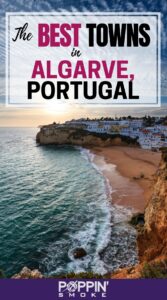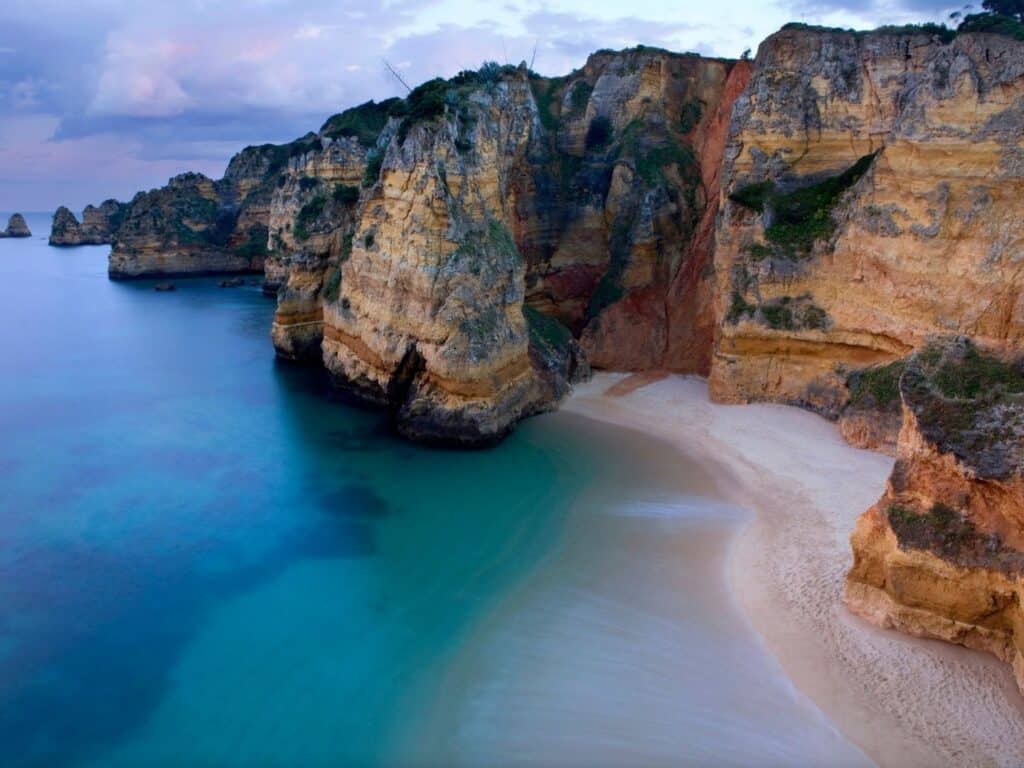
Algarve, Portugal’s southernmost region, has become one of the most popular destinations in Western Europe, and for good reason. Best known for its stunning coastline decorated with golden beaches, towering cliffs, distinctive rock formations, and turquoise water, Algarve is the perfect place for outdoor adventurers and nature lovers. But the region offers something for other travelers as well. It’s a great option for those who enjoy quaint, small villages with rich history, plus it has many resort towns and luxury hotels surrounded by well-manicured golf courses.
To help you choose the best places to visit in Algarve and where to stay, read these recommendations from fellow travel experts and locals!
Contents (click to expand)
Albufeira
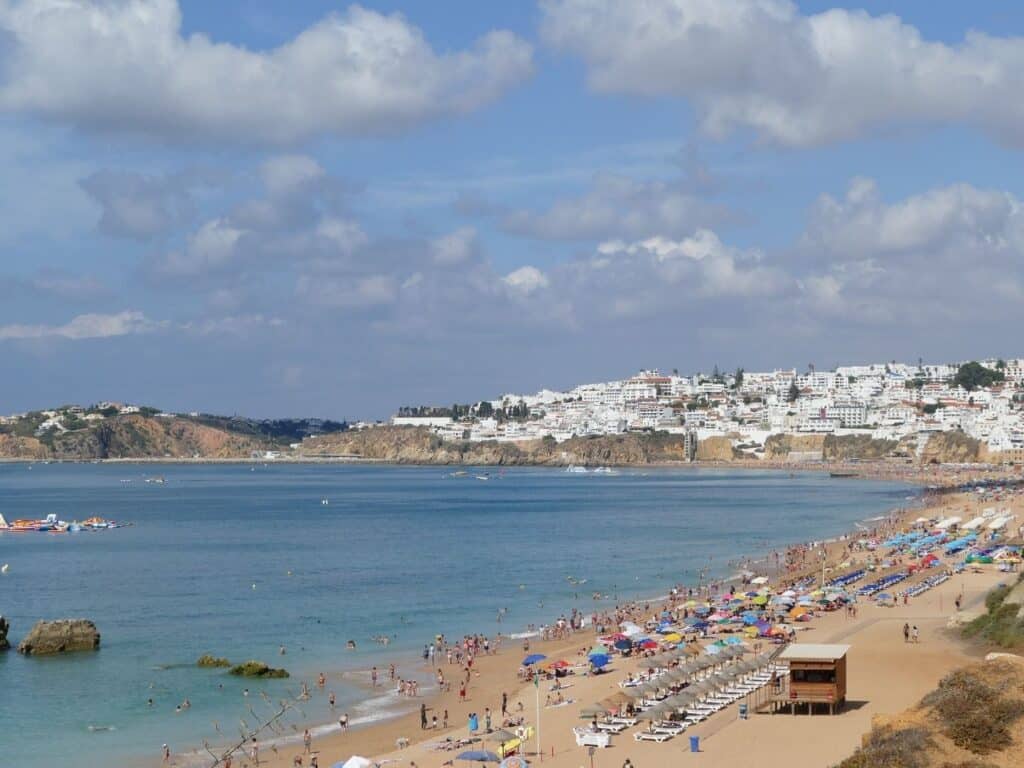
Albufeira is a beautiful little beach town located on the central coast of Algarve. It should be high on your list of places to see in Portugal, especially if you’re planning a road trip, the best way to explore the region.
Formerly a fishing village, Albufeira is now the largest resort town in Algarve and is best known for its historic center, beautiful beach, and nightlife. There are many little bars and restaurants to choose from, so you’ll always have something to do.
Albufeira’s beach is absolutely gorgeous and offers plenty of things to do. You can try water sports, like kayaking, stand up paddle or other fun activities, although simply relaxing by the ocean is a must.
Of course, you should try local seafood specialties, for which Portugal is so well known. Food and drinks tend to be budget-friendly, and even if you eat out you won’t need to spend a fortune.
If you want to fully experience the lively atmosphere of Albufeira’s high season, the best time to visit is definitely during the European summer, in July and August. This is when the weather will be hot and sunny, and many Europeans are here on holiday. For fewer crowds, but reliably good weather, visit Albufeira in May/June or September.
Two recommended hotels are the Hotel Baltum, which is small and centrally-located with a nice rooftop bar, or the more upscale Hotel Sol E Mar, situated directly on the beach with beautiful oceanfront views.
(Pro tip: if you have a car, don’t park in the center of town. This garage is much cheaper, but still walking distance from the action.)
– Contributed by Victoria from Guide Your Travel
Armação de Pêra
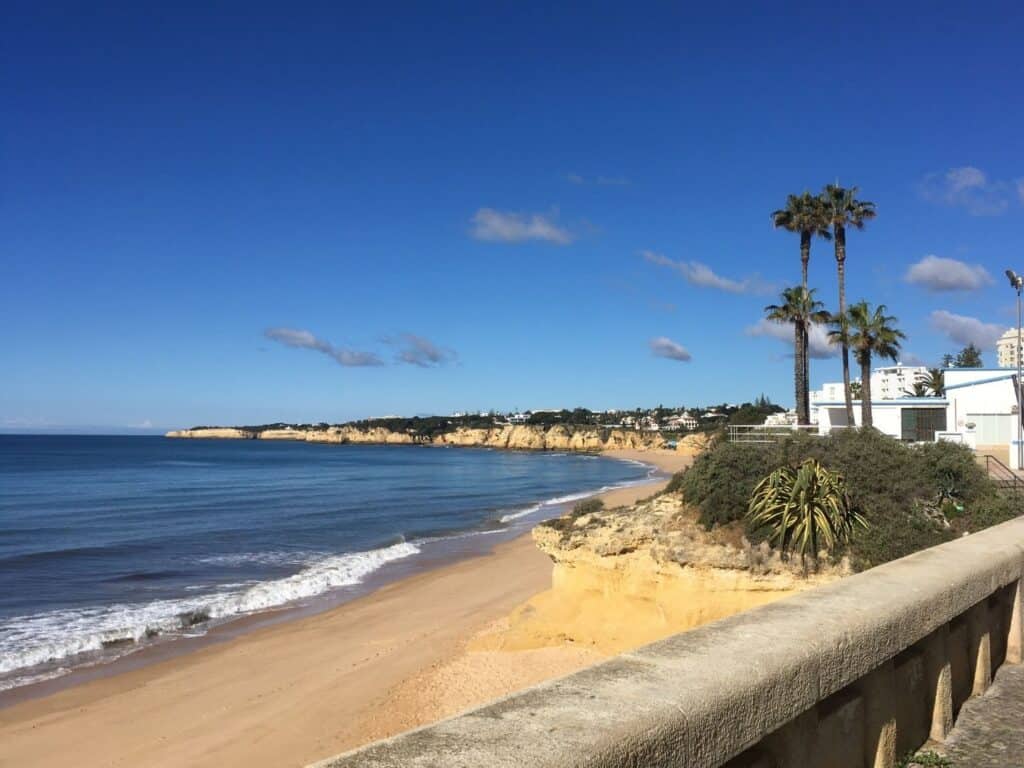
Lovely, relaxed Armação de Pêra often gets lost in the shuffle among the more well-known tourist towns nearby, such as Portimão and Albufeira. It sees fewer tourists than those places as well, and the closest it has to the big resorts found other places along the southern Algarve coast is the relatively understated Holiday Inn overlooking the main beach. Most visitors instead choose one of the many comfortable and affordable apartments for rent along the malecón (boardwalk).
Armação de Pêra boasts plenty of excellent restaurants, a tiny, jumbled old town, a bird-filled lagoon, and an impressive mix of beaches. Although technically separated into multiple different beaches, an unbroken stretch of beautiful sand runs the entire 5 kilometers southeast to the town of Galé.
The most unique feature of Armação de Pêra, however, is the phenomenal line of oceanside cliffs leading west from the edge of town. These amazing, rocky cliffs hide numerous little coves, hidden beaches, and photogenic caves. You can walk to dramatic Praia da Marinha (7 km each way), or continue all the way past the Benagil Caves to Portimão (17 km) and take the bus back, or simply walk as far as you want, then retrace your steps.
Like most Algarve beach towns, Armação de Pêra gets very hot and very busy in mid-summer. If you have a choice, it is best to visit in the shoulder seasons of May-June or September-October.
– Contributed by Dean and Laynni at Routinely Nomadic
Benagil
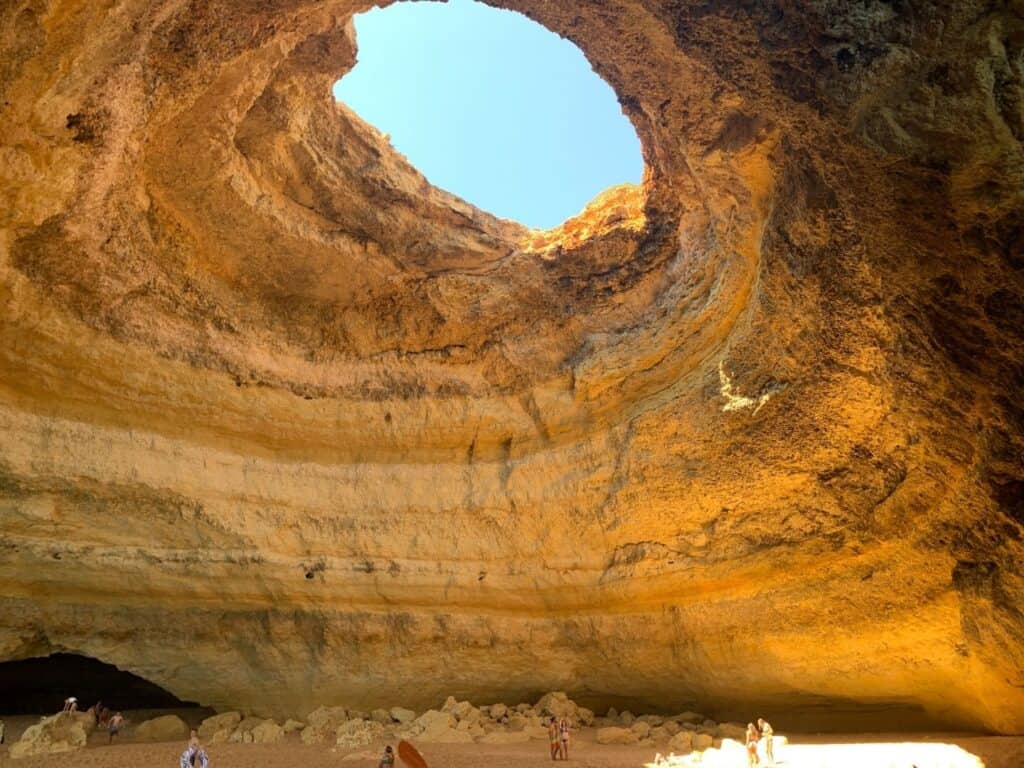
The small fishing village of Benagil plays host to one of the Algarve’s, if not Portugal’s, most visited landmarks, the Benagil Cave. If you’ve seen any photos of caves in the region, then most likely you have seen this sea cavern, with a gigantic hole at the top, letting in a shaft of golden light.
The iconic shaft of light shines through the open top, making the whole cave appear dreamlike. The turquoise sea glistens, and light bounces off it onto the pale sandstone walls. The caves do get very busy, so if you’re not restricted by time, try to visit during off-peak season and earlier in the day.
The region is dotted with numerous caves, with the Benagil Cave being the most popular of them all. To visit it, you’ll need to go by boat, kayak or paddleboard. Boat trips can be organized from most towns along the south coast, and you can rent kayaks/paddleboards from the village itself, where there are several hire shops offering group tours to the caves.
The nearest village to the cave is of the same name: Benagil. You could stay here, however, there isn’t much around this area, especially after the visitors have left and the shops and bars have closed up. I would suggest staying in one of the larger towns close by and then driving to Benagil for a day trip. There is a large car park at the top of the cliff, and you can walk down to the cove to rent a kayak.
If you’re without a car, then the best way to visit the caves is by boat. However visiting by boat, you don’t actually disembark – you just sail into it. If you want to set foot on the sand and take photos inside the cave, then you’ll have to go by kayak or paddleboard. Whichever way you choose to visit, it’s a must-see place in the Algarve.
– Contributed by Becki from Meet Me In Departures
Carvoeiro
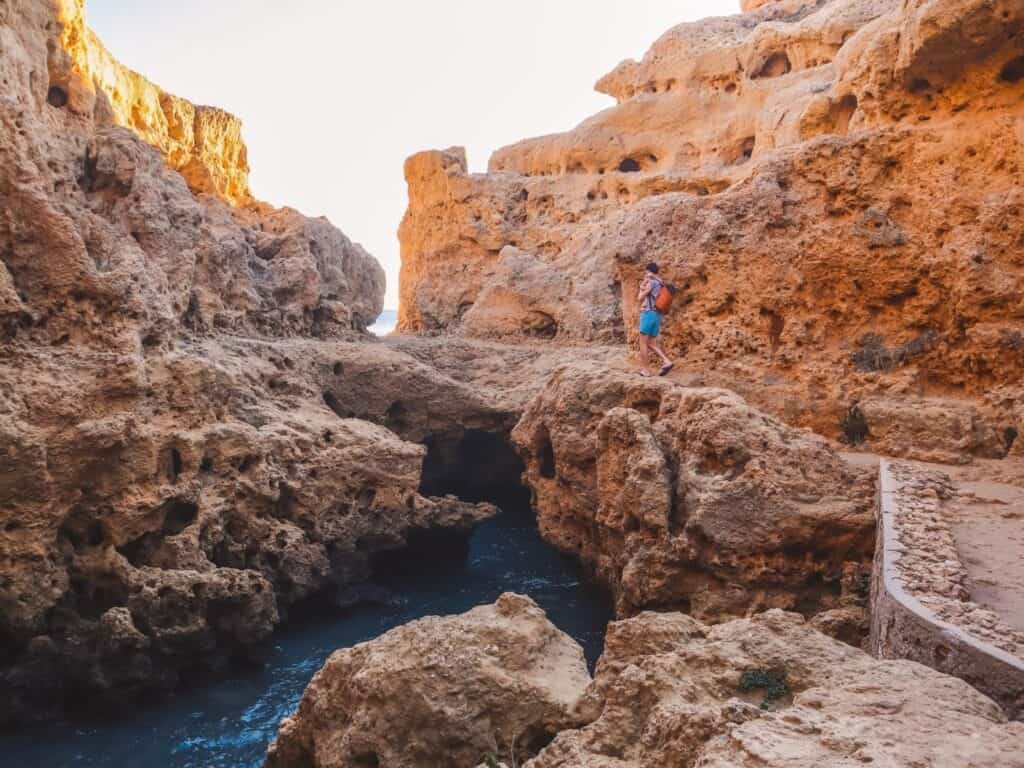
The beach town of Carvoeiro is one of the smaller towns in the Algarve, yet one of the most popular, because of its perfect location close to stunning beaches, impressive rock cliffs and beautiful hikes. It makes a great place to base yourself during your Algarve trip.
The Carvoeiro beach is spectacular and well-maintained, with showers, bathrooms, and restaurants, but it’s quite small. It can get busy during the summer months, but that’s not really a problem, as there are many more beautiful beaches nearby.
When staying in Carvoeiro, make sure to bring your hiking boots and explore the best Algarve beaches along the Trail of Headlands. It starts (or ends, depending on which direction you prefer) in Carvoeiro and ends in the small town of Ferragudo. You’ll walk along the beautiful orange Algarve rock cliffs and you’ll pass some of the most stunning beaches, like Praia do Paraiso, which you can only access via a rock tunnel. You can take an Uber back for about 6 Euros.
If hiking is not your thing, or the summer heat keeps you closer to town, you can experience the Algarve rock cliffs closer to Carvoeiro as well. Make sure to visit the Carvoeiro Boardwalk, which runs along the cliffs. There are two spots with stairs leading down to the beach, and it is highly recommended to go down at both spots. You’ll get to visit the Algar Seco caves, including one of the natural rock pools, where you can take a dip.
Stay at the Algar Seco Parque for spectacular views and a great location close to the Carvoeiro Boardwalk.
– Contributed by Maartje from The Orange Backpack
Castro Marim
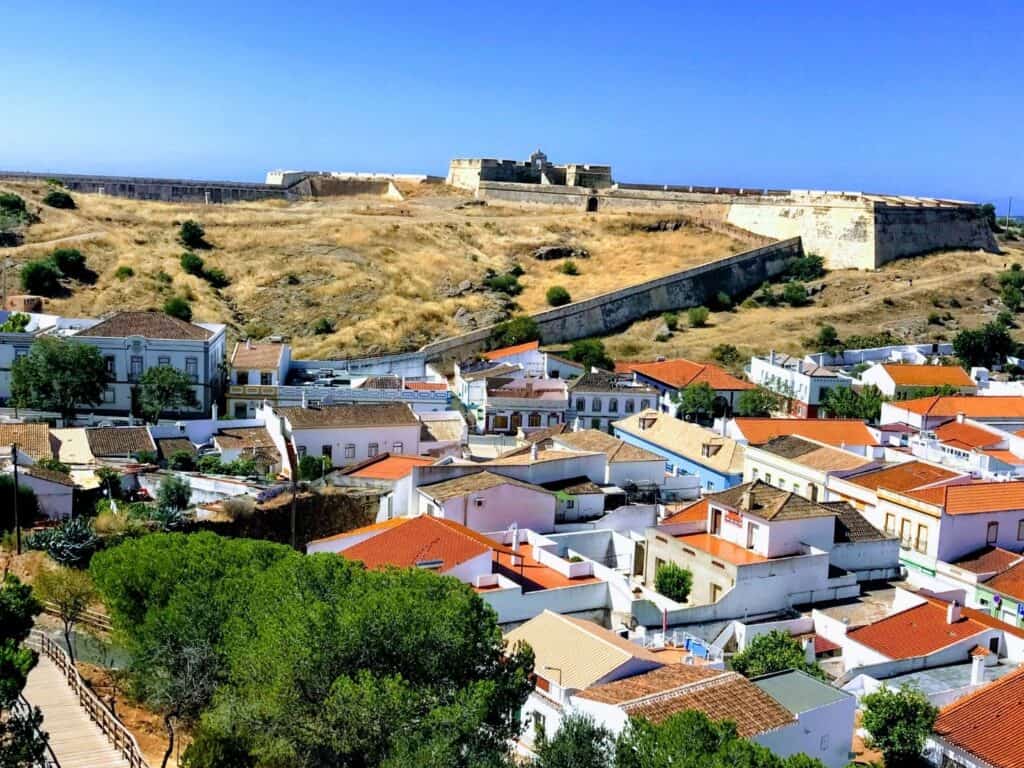
If smuggling, roman salt secrets, and the Knights Templar interest you, then Castro Marim is a fabulous day trip. Visit the medieval castle where the Knights Templar hid out when the Pope and King of France were trying to erase their existence (and take their money) in the 1300s.
Don’t miss the salt museum and salt pans to find out about this valuable spice, which was used to pay salaries (sal is the Latin word for salt which became “salary”) for roman soldiers. Castro Marim salt was so prized that if someone let out the secret of how it was made, they would lose their life.
Visit the castle and walk around the top of the walls for great views and photos of neighboring Spain, the Guadiana River, and rolling hills. Circle around the base of the castle to see historic homes, taverns, and shops. Don’t forget to visit the church inside the castle property to check out medieval torture history.
Climb up the small hill to the Revelim for more great views, to picnic in the gardens, and to visit the Santo António Chapel. Imagine the old artillery platform built there to control the river traffic to town, as Castro Marim used to be a major trading port.
The nearby preserves are a prime location for bird watchers, bikers, and trekkers where you can see flamingoes, storks, and more in an eye-catching setting.
Visit in August when the town travels back in time and transforms into a medieval showcase filled with historical activities, food, music and craft products or in May/June or September as it can get warm and more crowded in the summer months.
– Contributed by Veronica Ondrejech (American in Portugal)
Faro
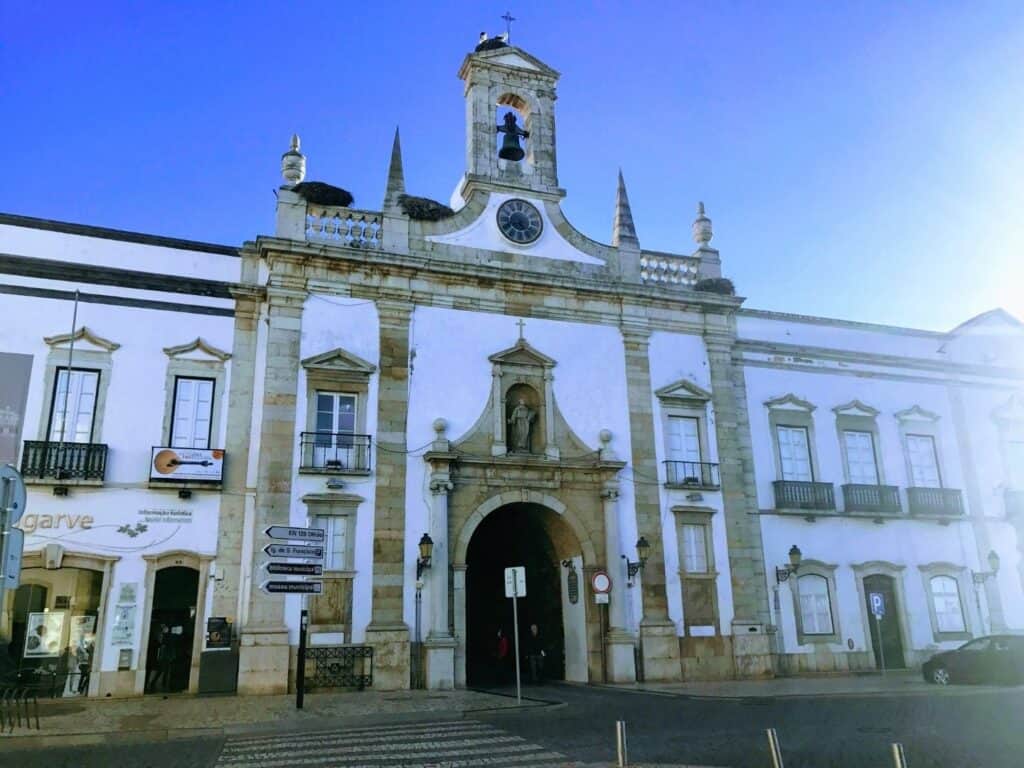
Faro is the capital of Algarve, and many tourists pass right through it after they land at the airport. This is a pity, as the city has a great atmosphere, its own share of gorgeous beaches, and many other tourist attractions. Faro offers the opportunity to have the best of both worlds: a cosmopolitan city break and a relaxing holiday at the beach.
Among the many attractions in Faro, you can’t miss the Old Town. Pass through Arco da Vila (the town gate) and wander around the maze-like narrow streets. All of them converge at the Cathedral Square, a symbol of the city and of the Algarve. Inside, there is a museum with religious artifacts and altars collected from churches in the region. Climb the tower for a splendid view over the old town, the marina and Ria Formosa Natural Park.
No trip to Faro is complete without a boat trip through the canals of Ria Formosa, a shallow lagoon and one of Portugal’s Natural Wonders. Most excursions combine it with stops at the distant sandy islands that separate it from the sea.
The coastal city of Faro can be visited year round, depending on what you’re looking for. Spring, summer and autumn are great for swimming and sunbathing, while winter is perfect if you’re looking to spend the colder months of the year in a milder climate, but still in Europe.
In order to enjoy the best things to do and see in Faro you need at least two days. Faro also makes a great base from which to visit the other beautiful towns in Algarve. Stay at Eva Senses Hotel, which is in a perfect location next to the marina and the historic center. It also has its own private beach, outdoor pool, and a spa.
– Contributed by Raluca from Travel With A Spin
Lagos
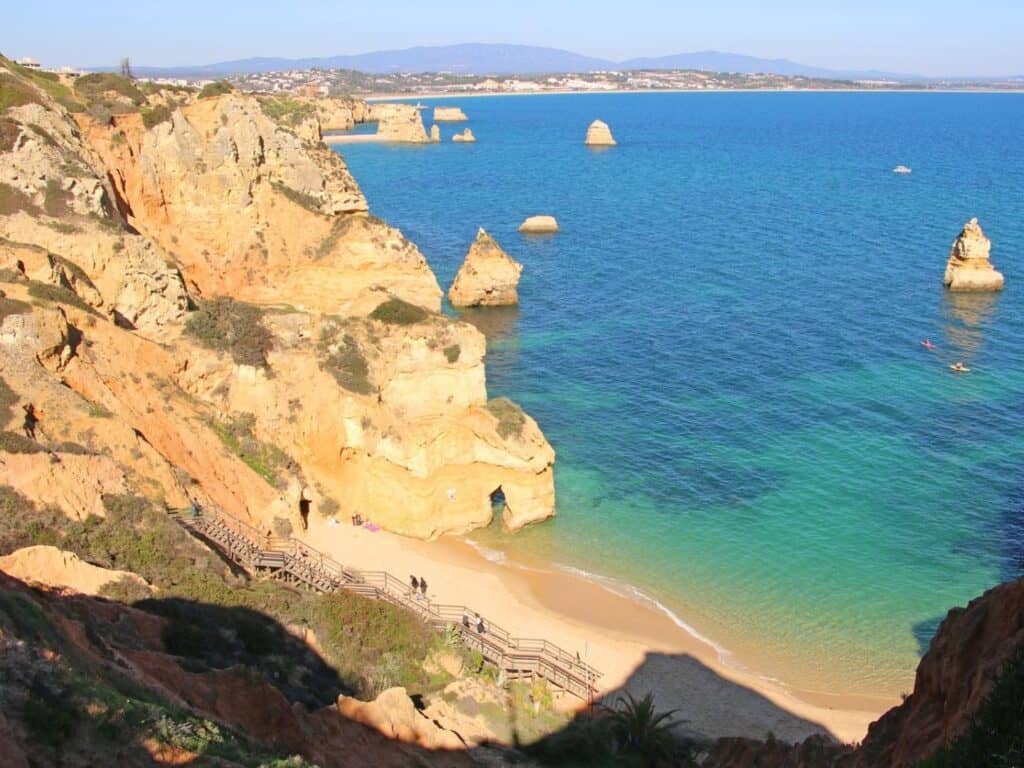
Lagos is a beautiful town situated on the west coast of Algarve. It’s a great place for a summer holiday. The scenery around Lagos is spectacular; rugged limestone cliffs, sandy beaches, dramatic drops, stunning lookout points, and turquoise water. The town is famous for its beaches; Praia do Porto de Mós, Dona Ana, Praia dos Estudantes, and Praia do Camilo are some of the best beaches in Lagos.
There are many amazing things to do in Lagos. Kayaking is the best way to see the limestone cliffs, to explore secret caves, and to visit some difficult-to-access beaches around Lagos. Boat tours offer a great opportunity to see dolphins.
Surfing is another popular activity in the town. Praia do Porto de Mós and São Roque are the best surf beaches in Lagos. Several surf shops and schools offer gear rental and classes for beginners.
Visiting Ponta da Piedade is also a must-do activity in Lagos. Walking trails at Ponta da Piedade offer breathtaking views of the cliffs and the sea.
Most people spend a week or two in Lagos during their summer holiday. Some people come here for a couple of months to escape the European winter. Some live here for a year or so as digital nomads.
| Related Reading: A Two Month “Slow Travel” Portugal Itinerary
May – June and September – October are the best months to visit Lagos, because it’s sunny and warm, but not too hot and not too crowded. July and August are the peak season in the Algarve and the hottest time of the year. For those who want to enjoy spring blossoms, March and April are the perfect time to come to Lagos.
Stay at the Hotel Marina Rio, a family-run hotel that overlooks the marina and is only a short walk from the historic center of Lagos.
– Contributed by Alya and Campbell of the Algarve Family
Odeceixe
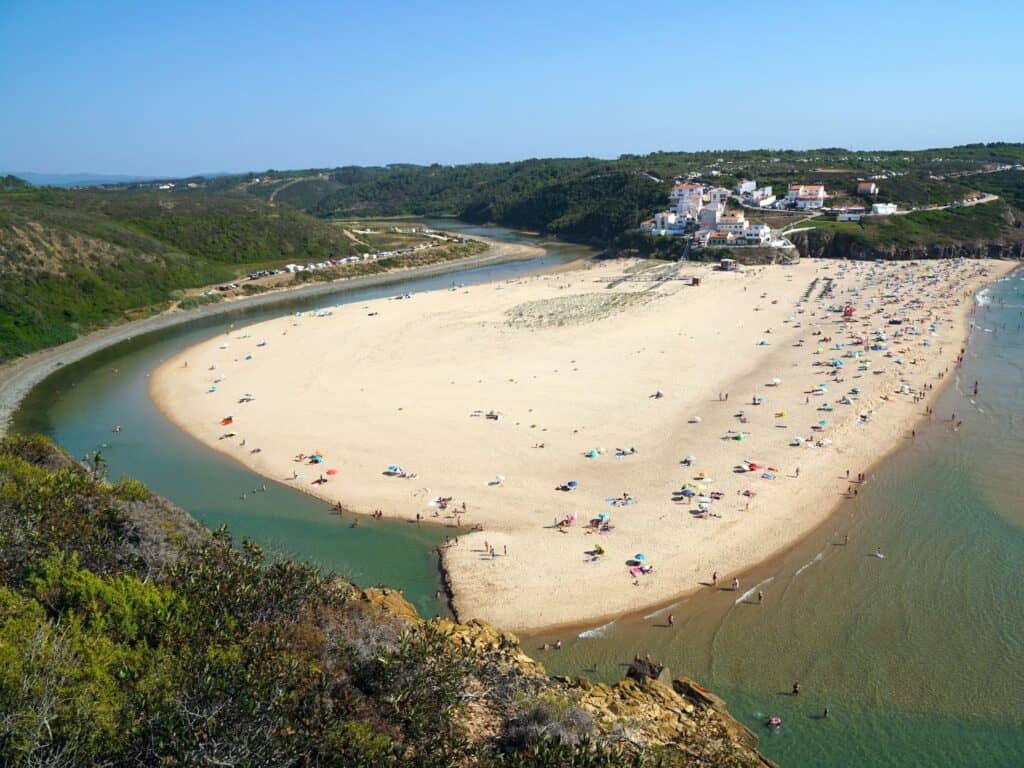
The enchanting village of Odeceixe rests on a gorgeous seaside hill, topped with a historic windmill and filled with steep cobblestone alleys and a vibrant town center plaza.
My favorite excursion is to walk the Fishermen’s Trail, part of the Rota Vicentina network. It’s 75 miles long with stops along tiny seaside villages the entire way, terminating in Odeceixe.
The best time of year to visit is September through June, as the weather is gentle and sunny. Portuguese families will fill the streets and world famous beaches, such as Praia de Odeceixe, for surf camps, horseback riding and seafood dining.
The Bohemian Antique Guesthouse is a fabulous and authentic place to stay right in the heart of the village. Two to three days would be the perfect amount of time to relax and explore all this town has to offer.
Everyone should travel to Portugal to experience the magnificent cities — but the small towns like Odeceixe really let you step off the touristic treadmill and feel like a local. It’s perfect to pair with a visit to Lagos or Lisbon with easy transportation, either by public bus or rental car.
– Contributed by Morgan from Crave the Planet
Portimão
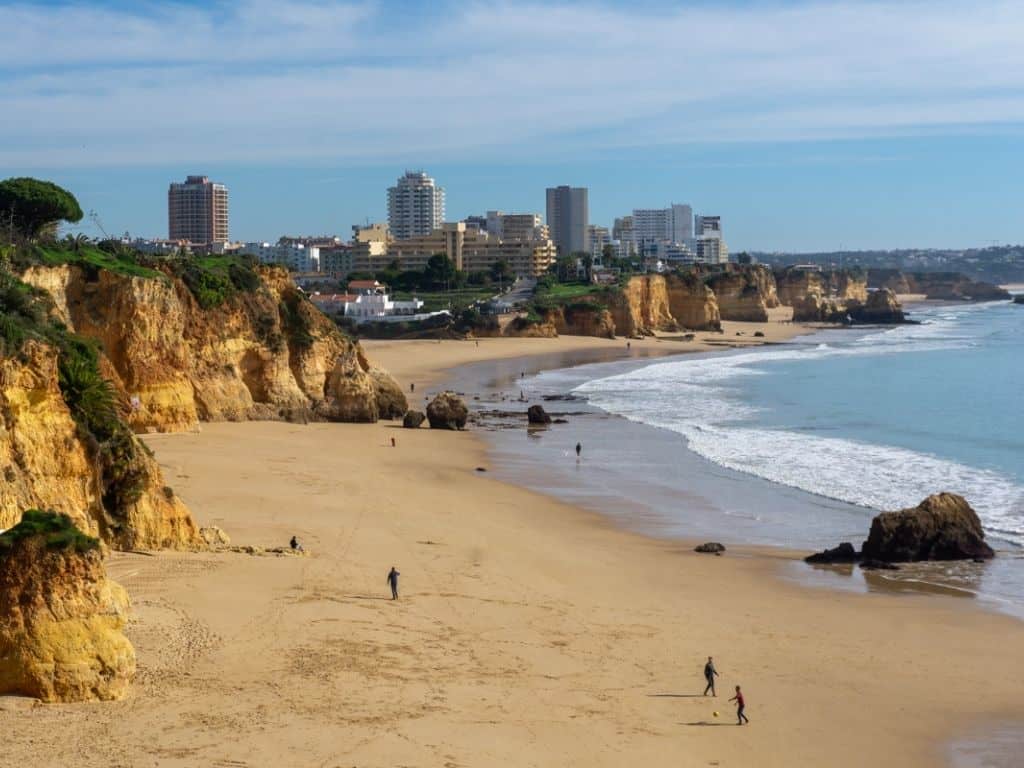
Portimão is one of the largest cities in the Algarve and is mostly known for the Autódromo Internacional do Algarve, where the Portuguese Grand Prix was held in 2020. It used to be important for shipbuilding and fishing. Portimão is also known as the place to eat the most delicious sardines in Portugal.
The city is home to some really beautiful beaches with the golden cliffs that are typical of Algarve. The best beaches to explore are Praia dos Três Castelos and Praia da Rocha, where you’ll also find the most beach bars.
There are also fun things to do in the city center, like visiting the gorgeous Igreja do Colégio and the interesting Jardim 1º de Dezembro, where the artwork on the benches tells the history of Portugal.
If you like hiking, Portimão is also a great place to visit. Follow the beaches in the western direction. There, you can climb up to Ponta João de Arens, a beautiful cliff, from where you have the best view of the city of Portimão.
The best thing about Portimão? Every other highlight in the Algarve is less than an hour’s drive away, and you can even go on boat trips to Silves and the famous Benagil caves. Stay at the AP Oriental Beach Hotel (right on Praia da Rocha) and you have the perfect base for your Algarve vacation!
– Contributed by Jacoba from Op Reis Met Co
Sagres
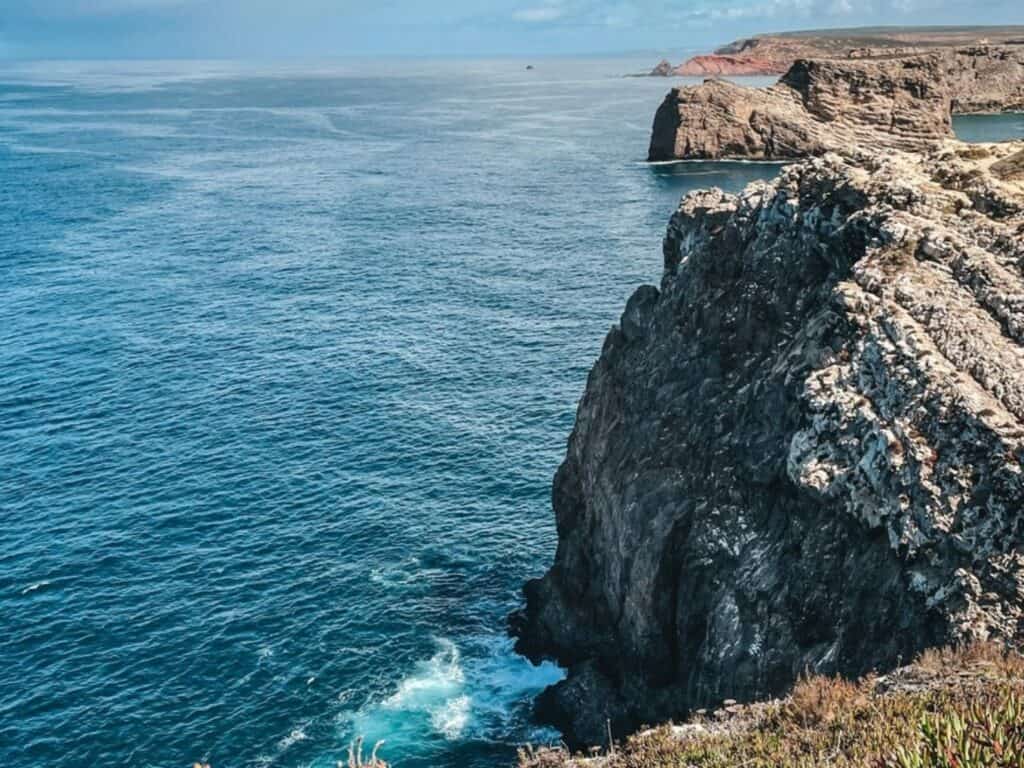
Sagres is a small surf town on the southwestern side of Algarve. While Ericeira is the surf capital of Portugal, Sagres is the top surf spot in Algarve. The town is known for its good waves and the spectacular sunset view. You can take a surf class there, or if you already know how to surf, you can rent a board and go surfing on your own.
If surfing is not your thing, you might want to sunbathe on one of the beaches. I recommend visiting Praia de Beliche, a beautiful sandy beach located at the bottom of a cliff. If you want a quieter beach with fewer people, check out Praia do Marinhal. “A Sereia” is a great seafood restaurant overlooking the sea near Praia do Marinhal.
Another must-do in Sagres is watching the sunset at Cabo Sao Vicente, the southwestern most point of mainland Europe. Sit on the rocky cliffs around the lighthouse and enjoy the stunning view of the sun going down over the Atlantic Ocean.
Sagres is a small town, so a day trip is enough to see most of it. However, if you go there for surfing, you might want to spend a few more days. Pousada do Sagres is a lovely hotel next to the main beach of the town, and Sagres Sun Stay is a great hostel for budget travelers and backpackers.
– Contributed by Maria from A World of Destinations
Tavira
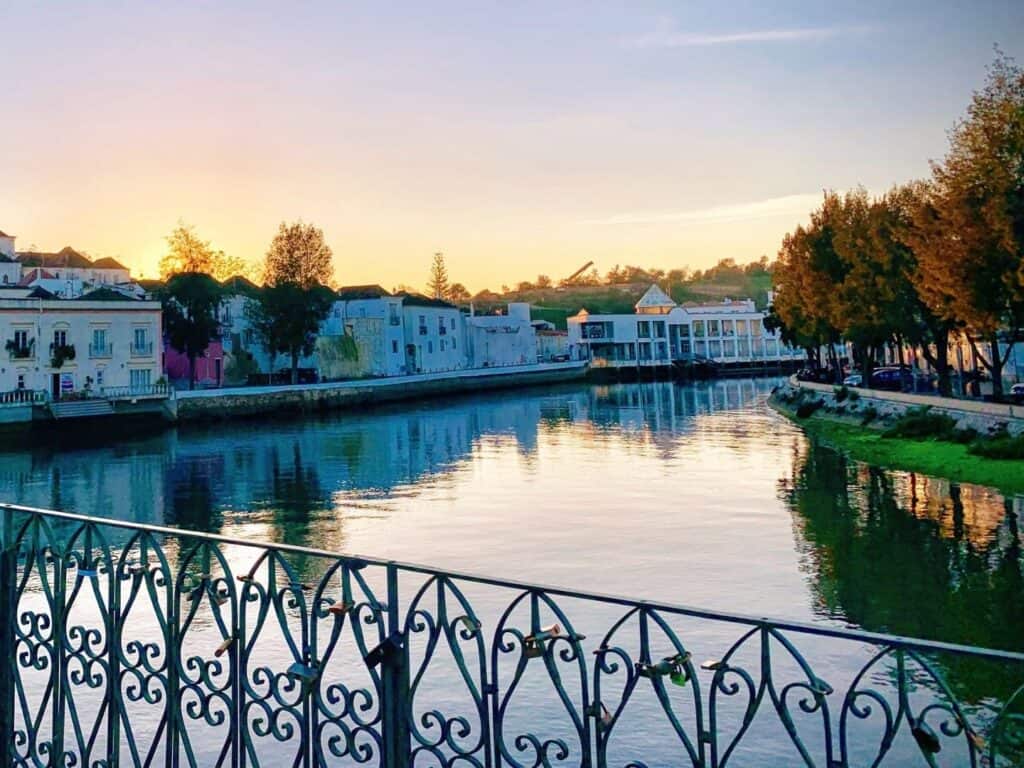
The Algarve region is known for its golden beaches, almost year-round sunny weather, and beautiful seaside villages and resorts that dot this stunning coastline. Among the most beautiful of these gems is the charming town of Tavira.
Tavira, which is conveniently located only a short 35-minute drive from Faro Airport and around 30 minutes from the Spanish border, is a must-visit for anyone heading to Algarve in Portugal.
Despite Algarve’s popularity, Tavira has managed to retain its authenticity and is still very much untainted by the throngs of tourists that flock to the region annually. The town itself is vibrant and a pure delight to explore as you admire the colorful buildings, many of which are adorned by beautifully-patterned tile work.
Head to the Praça da Republica, as you explore the old town, which features views over the Roman Bridge along the Gilão river, and enjoy a riverside bite to eat whilst admiring the charming architecture and sights. A short walk away you will find the Tavira Castle, where you can stroll through the lush gardens and enjoy views out over the town.
Of course, many visitors flock to Algarve for its world-class beaches, and Tavira is no exception. The Ria Formosa Nature Reserve is located just south of Tavira and also boasts the Ilha da Tavira (Tavira Island). Take a dip in the turquoise waters of Praia da Terra Estreita, or visit the “Graveyard of Anchors” at Praia do Barril.
The best time to visit Tavira, and Algarve in general, would be from around mid-May through June, or from mid-September through October when the weather is still pleasant and the area is far less crowded compared to the peak months of July and August.
Consider booking a night or two in the gorgeous 4 star Pousada Convento de Tavira, to allow you a few days to really get to know Tavira and its surroundings.
– Contributed by Marco from Travel-Boo
Vila Real de Santo António
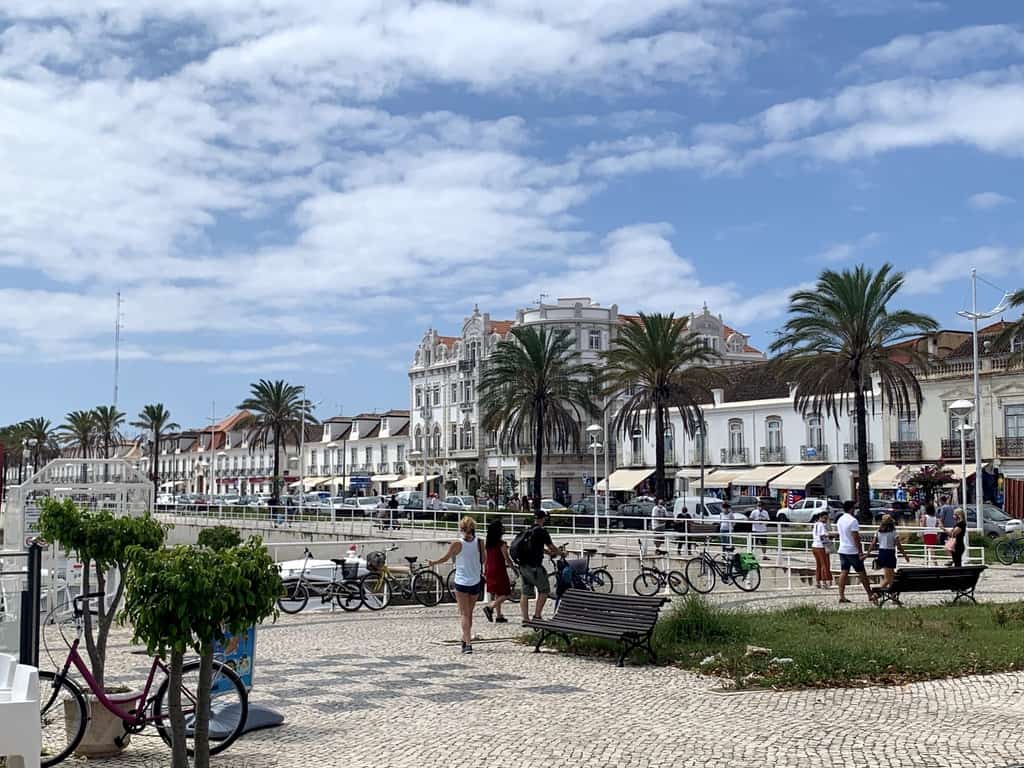
Vila Real de Santo António (VRSA) is nestled in the most southeastern corner of Portugal, where the Guadiana River (the border between Spain and Portugal) meets the Atlantic Ocean. This perfect little triangle, bordered by beautiful beaches, the river, and nature preserves, makes it a great trip for a variety of travelers.
The best things to do while you’re visiting VRSA are to stroll along the riverwalk, bike or walk through the pine-covered trails next to the beach, and visit the flamingoes in the preserves north of town. You can rent a bike at Bcool Scooters near the square to enjoy the off-the-beaten-path trails.
Many people visit VRSA just for the shopping and cafes near the city square. Kids can safely run around the pedestrian-only center of town. Fabulous pottery, linens, and Casa Caravela shops are a favorite here. Built by royal decree it’s a “Little Lisbon” and a perfect example of the beautiful Pombaline architecture famous in Portugal.
| Related Reading: Living in Algarve as an American Expat
Plan 5 days to a week for your visit and include some beach time along some of the Algarve’s least- crowded beaches full of fluffy sand, seashells, and dunes. Take the 10-minute ferry across the Guadiana River for tapas and more shopping in Ayamonte, Spain. Getting on the water while boating across the river is always a treat for only 1.90 euros each way.
My favorite hotels are the Pousada Vila Real de Santo António, located right in the town square, and the Grand House, which was the first upscale boutique hotel in the Algarve. Visit during May/June and early September for the best weather and fewer tourists.
– Contributed by Veronica Ondrejech (American in Portugal)
Ready to visit Algarve?
Algarve is one of the best places in Europe to visit if you’re seeking great weather, fresh and delicious food, a variety of things to do, and affordability. This beautiful and sunny region of southern Portugal has something for everyone, whether you’re traveling as a couple, with the family, or on a solo adventure!
Have you visited Algarve? Tell us your favorite town in the comments below!

